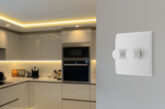
As of September 2021, there has been a major overhaul to the energy ratings displayed on light bulbs, with the revision reflecting broader changes in the way energy efficiency is measured and regulated in the UK. The team at Enkin provides more detail.
The energy ratings displayed on bulbs are designed to help us understand how much energy that bulb uses, and how efficient it is in comparison to other options. These ratings are classified using lumens per watts; the higher the lumens, the higher the classification. This is displayed on the side of bulb packaging, with classifications from green to red, to easily identify which bulb is more energy efficient.
Fairly simple, right? Not quite. This classification has seen a drastic shift in recent years, and you might have noticed that the A++ energy rated bulb you usually purchase now has an energy rating of E. It can seem concerning, especially if you’re meticulous about saving energy in the home.
However, this isn’t a cause for concern. Bulbs have not suddenly become less efficient, the rating system has simply updated to reflect a new standard for industries to aim for when producing energy efficient bulbs.
Here’s how it works:
Advancements in lighting technology
The most significant reason for the shift in energy ratings is the rapid development in lighting technology. Traditional incandescent bulbs, which were less efficient, have been largely replaced by LED lighting.
This newer technology consumes significantly less energy and has a much longer lifespan, necessitating a re-evaluation of what constitutes an ‘efficient’ bulb.
However, the phase out of incandescent and halogen bulbs brought with it a new problem, as the vast majority of LED bulbs were being rated as A, A+ or A++, when compared to their highly inefficient predecessors.
With so many bulbs rated in the highest category for energy efficiency, there was no reason for manufacturers to develop more energy efficient technology.
Simply put, the new energy ratings incentivise producers to continue developing more energy efficient bulbs.
Setting global standards
Globally, there has been a significant push to align industry standards when it comes to energy efficiency. Aligning the criteria used in different regions makes it easier for consumers to compare products.
In 2021 the EU took steps to achieve this by revising the energy labelling system, providing more accurate information in a much clearer way for the consumer.
The scale, which previously ranged from A+++ to G, was simplified to A to G, with no additional “+” categories. This change was made to account for the high efficiency of modern LEDs, ensuring the labels remain relevant and informative.
Environmental considerations
With the increasing emphasis on reducing energy consumption to combat climate change and lower energy bills for consumers, the need for more stringent standards on energy ratings helps to drive the adoption of more efficient technologies.
This aids in reducing overall energy consumption, greenhouse gas emissions, and helps to save us all a few pennies on our energy bills.
What do these changes mean for you?
1. Easier comparisons
Revised energy ratings and clearer labelling with more accurate information makes it easier to compare the efficiency of different bulbs. The new system aims to paint a clearer picture of energy consumption, helping you to make a more informed decision when purchasing.
2. Incentivised efficiency
With manufacturers now being incentivised to create more energy efficient bulbs, older, less efficient bulbs will gradually be phased out, lending to a more energy efficient market for LED bulbs in general. Consumers are more likely to purchase a more efficient LED bulb, which proves to be more cost-effective over their lifespan, despite the higher upfront cost.
3. Environmental impact
Along with the long-term savings from using more sustainable LEDs, choosing bulbs with a higher energy rating helps reduce your carbon footprint and contributes to broader environmental goals.
These recent changes in energy ratings on light bulbs reflect the ever-evolving landscape of lighting technology, as well as the global effort to promote energy efficiency and sustainability.
By being aware of these changes, and as technology continues to advance, we can make decisions that benefit both our wallets and the environment. We can expect to see more changes like this in future that will further fine-tune how we measure and communicate energy efficiency, so it’s crucial to stay informed.
Browse Enkin’s range of LED dimming technology solutions here
Find more technical articles here









